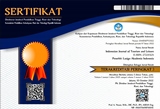Perceived Safety and Security Concerns among Tourists in Thamel-A Tourism Hub in Kathmandu Valley, Nepal
Abstract
The safety and security of a destination is an essential factor that helps travelers decide whether to visit or not. In Nepal, Thamel is the main destination for tourists due to the availability of multiple facilities and services. In fact, most of the tourists who use airspace to travel to Nepal, start and conclude their journey in Thamel. Therefore, the safety and security of Thamel is an important factor that influences the fate of the Nepalese tourism industry. However, there is a lack of research to understand the safety and security situation of Thamel. The purpose of this exploratory study is to assess the overall security situation and challenges in Thamel. Descriptive statistics are used to present the findings. Findings suggest that Thamel as a tourism destination has many areas for improvement to provide better tourist experiences. Since Thamel is a starting and concluding point of attraction for tourists, we offer important managerial implications and future research directions.
Full Text:
PDFReferences
Adhikari, S. (2019). Prospects of tourism in Nepal: A study of Pokhara city. A thesis is submitted to University of Applied Science. Retrieved from https://www.theseus.fi/handle/10024/165831.
Berendien, A. L. (2015). Measuring the competitiveness of South Africa as a tourist destination. Travel and Tourism Research Association: Advancing Tourism Research Globally, 12.
Bhatta, C. (2016). The Role of Arts in Promoting Tourism: A Case of tourism Development in Thamel Area. Journal of Advanced Academic Research, 3(1), 177-184.
Bianchi, R. (2006). Tourism and the globalisation of fear: Analysing the politics of risk and (in)security in global travel. Tourism and Hospitality Research, 7(1), 64-74.
Borgatti, S. P., Everett, M. G., & Freeman, L. C. (2002). UCINET 6 for Windows: Software for Social Network Analysis. Harvard, MA: Analytic Technologies.
Gammon, S., & Robinson, T. (2003). Sport and tourism: A conceptual framework. Journal of Sports and Tourism, 8(1), 21- 26.
Garcia-Altes, A. (2005). The development of health tourism services. Annals of Tourism Research, 32(1), 262-266.
Garg, A. (2015). Travel risks vs tourist decision making: A tourist perspective. International Journal of Hospitality & Tourism Systems, 8(1), 1-9.
Griffin, C. E. (2005). The imperatives of regional governance: Securing the tourism sector and enhancing human security. Social and Economic Studies, 54(4), 13-41.
Hagen, T. (1994). Building Bridges to the Third World: Memories of Nepal, 1950–1992. Delhi: Book Faith India.
Hall, C. M., Scott, D., & Gössling, S. (2020). Pandemics, transformations and tourism: be careful what you wish for. Tourism Geographies, 22(3), 577-598.
Hall, C. M., Timothy, D. J., & Duval, D. T. (2004). Security and Tourism. Journal of Travel & Tourism Marketing, 15(2-3), 1-18.
KC, B. (2020). Ecotourism for wildlife conservation and sustainable livelihood via community-based homestay: a formula to success or a quagmire? Current Issues in Tourism, Online First: https://doi.org/10.1080/13683500.2020.1772206
KC, B., Paudyal, R., & Neupane, S. S. (2018). Residents’ perspectives of a newly developed ecotourism project: an assessment of effectiveness through the lens of an importance-performance analysis. Asia Pacific Journal of Tourism Research, 23(6), 560-572.
Kekovic, Z., & Markovic, S. (2009). Security as a factor of competitive advantage in tourism. Tourism & Hospitality Management, 15(2), 291-303.
Kovari, I., & Zimányi, K. (2011). Safety and security in the age of global tourism (The changing role and conception of safety and security in tourism). Applied Studies in Agribusiness and Commerce, 5(3-4), 59-61.
Larsen, S., Brun, W., & Øgaard, T. (2009). What tourists worry about – Construction of a scale measuring tourist worries. Tourism Management, 30, 260–265.
Lepp, A., & Gibson, H. (2003) Tourist roles, perceived risk and international tourism. Annals of Tourism Research, 30, 606–624
Min, J., KC, B., Kim, S., & Lee, J. (2020). The impact of disasters on a heritage tourist destination: A case study of Nepal earthquakes. Sustainability, 12(15), 6115.
MoCTCA (2019). Nepal Tourism Statistics 2018. Singha Durbar, Kathmandu, Nepal.
Muehsam, M. J., & Tarlow, P. E. (1995). Involving the police in tourism. Tourism Management, 16(1), 9-14.
Rasul, G., & Manandhar, P. (2009). Prospects and problems in promoting tourism in South Asia: A regional perspective. South Asia Economic Journal, 10(1), 187-207.
Sharifpour, M., Walters, G., Ritchie, B., & Winter, C. (2014). Investigating the role of prior knowledge in tourist decision making: A structural equation model of risk perceptions and information search. Journal of Travel Research, 53(3), 307-322.
Sharma, A. K. (2017). State of Tourism Security in Pokhara Valley. Saarbrucken: Lambert Academic Publishing.
Shrestha, H., & Shrestha, P. (2012). Tourism in Nepal: A historical perspective and present trend of development. Himalayan Journal of Sociology and Anthropology, 5, 54-75.
Shrestha, N. (2001). Political Economy of Land, Landlessness and Migration. Delhi: Nirala Publication.
UNDP (2007). Lessons Learned: Nepal's Experience Implementing Sustainable Rural Tourism Development Model of Tourism for Rural Poverty Alleviation Program. Retrieved from https://www.np.undp.org/content/nepal/en/home/library/poverty/lessons-learned--nepal-s-experience-implementing-sustainable-rur.html
UNESCO (n.d.). Properties inscribed on the World Heritage List: Nepal. Retrieved from https://whc.unesco.org/en/statesparties/np
Walter, P., Regmi, K. D., & Khanal, P. R. (2018). Host learning in community-based ecotourism in Nepal: The case of Sirubari and Ghalegaun homestays. Tourism Management Perspectives, 26, 49-58.
Walters, G., Mair, J., & Ritchie, B. (2014). Understanding the tourist’s response to natural disasters: The case of the 2011 Queensland floods. Journal of Vacation Marketing, 21 (1), 101-113.
Walters, G., Shipway, R., Miles, L., & Aldrigui, M. (2017). Fandom and risk perceptions of Olympic tourists. Annals of Tourism Research, 66, 210-212.
WTO (2020). International Tourism 2019 and Outlook for 2020. UNWTO, Madrid.
WTTC (2020). Economic Impact Reports. Retrieved from https://wttc.org/Research/Economic-Impact
DOI: https://doi.org/10.36256/ijtl.v1i2.122
Refbacks
- There are currently no refbacks.
Copyright (c) 2020 Indonesian Journal of Tourism and Leisure

This work is licensed under a Creative Commons Attribution-NonCommercial-ShareAlike 4.0 International License.
Indonesian Journal of Tourism and Leisure Indexed and Archieved By:

Indonesian Journal of Tourism and Leisure is licensed under a Creative Commons Attribution-NonCommercial-ShareAlike 4.0 International License.













